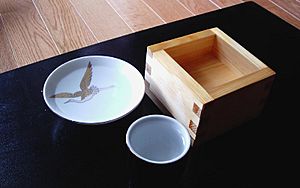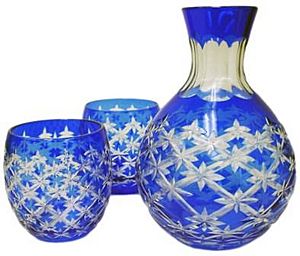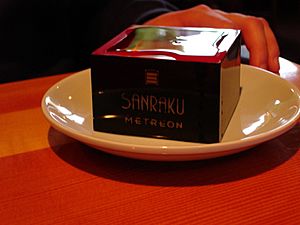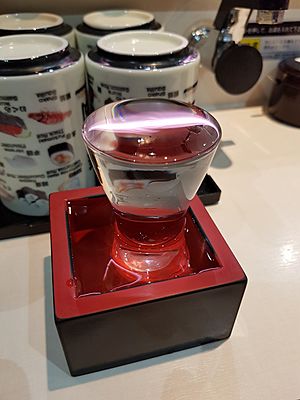Sake set facts for kids
A sake set (酒器, shuki) is a collection of special containers. These are used to serve and drink sake. Sake is a traditional Japanese alcoholic drink. Sake sets often come in ceramic materials. But they can also be made from wood, lacquered wood, glass, or plastic. You can buy the flask and cups separately. Or you can get them together as a set.
Serving Sake: The Tokkuri Flask
The main part of a sake set is a flask. It's called a tokkuri (徳利). A tokkuri usually has a round body and a thin neck. But it can also come in other shapes. Some look like a serving bowl with a spout, called a katakuchi.
Traditionally, people warm sake before drinking it. They often put the tokkuri filled with sake into a pot of hot water. The narrow neck of the tokkuri helps keep the heat inside. This stops the sake from getting cold too quickly.
In some traditional places in Japan, like oden bars, sake is warmed and served in metal containers. These are called chirori (銚釐) or tanpo (湯婆). Today, glass chirori are also used. These are good for chilling sake.
Cups for Drinking Sake
In the past, sake was sold in wooden box cups. These were called masu. A masu holds one gō, which is about 180 milliliters. People also used these boxes for drinking sake.
Long ago, people thought the wooden box went well with sake. This is because sake was often made in large wooden casks (樽). However, today, some sake experts do not like masu. They say the wood can change the taste of the sake.
Also, tradition says the masu should be filled to the very top. This shows good luck and wealth. Masu are now often made from lacquerware or even plastic. The word masu sounds like the Japanese word for "to increase" (増す). Because of this, the masu is still used in special ceremonies. It also shows generosity.
In some Japanese restaurants, a server might put a glass inside the masu. Or they might put the masu in a small dish. Then they pour sake until it overflows into the outer container. This is a way to show a lot of wealth and generosity.
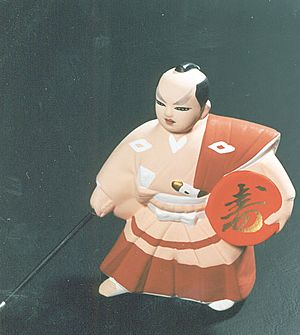
Today, sake is usually served in small ceramic cups. These small, round cups are called o-choko or choko (猪口). The "o-" is an honorific prefix. It is used to show respect, like in o-sake.
There are also flatter, wide-mouthed cups. These are called sakazuki. Sakazuki are special ceremonial cups. They are most often used at weddings and other important events. These can include tea ceremonies. Larger versions of sakazuki also exist.
While not traditional, a shot glass can also be used for sake. In the United States, it might replace an ochoko. In Japan, it is sometimes used with a masu. You can also find sake stemware. This is like a wine glass but designed for sake. Glass tokkuri and sake stemware are now commonly used for serving chilled sake.


